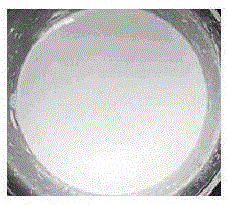A kind of novel lithium-ion battery diaphragm and preparation method thereof
A technology for lithium-ion batteries and diaphragms, applied in the field of preparing lithium-ion battery diaphragms, to achieve the effect of improving the performance of the pro-retaining liquid
- Summary
- Abstract
- Description
- Claims
- Application Information
AI Technical Summary
Problems solved by technology
Method used
Image
Examples
preparation example Construction
[0033] The preparation method of the novel lithium ion battery diaphragm of the present invention includes the following process steps:
[0034] (1) Soak the cotton fiber in water for 2-8h, defuse and beaten to obtain cotton pulp with a beating degree of 60°SR~80°SR;
[0035] (2) Wash the polypropylene fiber with sodium dodecylbenzene sulfonate and dry it;
[0036] (3) Mix the cotton pulp of the first step with the polypropylene fiber of the second step according to the mass ratio, add dispersant, adhesive, retention and filter aid, add water to dissolve and mix to make a slurry;
[0037] (4) The obtained slurry is dehydrated and squeezed through a copper mesh, and then dried in a dryer;
[0038] (5) Hot press at 135℃~150℃ to obtain finished diaphragm.
[0039] In order to improve the lyophilic performance and porosity of the lithium ion battery separator, the present invention adopts a wet papermaking process and uses cotton fiber and polypropylene fiber as the main substrate, which gre...
example 1
[0042] Step 1. Soak 360g cotton fiber in 5L water for 4h, add 18L water to the pulp tank of the beater, and beat the cotton fiber under pressure. The beating degree is measured every 10 minutes, and the beating degree is 60°, 65°, 70. °, 75°, 80° cotton pulp is ready for use.
[0043] Step 2: Wash the polypropylene fiber with sodium dodecylbenzene sulfonate to remove the grease on the surface of the polypropylene fiber, and then dry the fiber at 50°C-60°C.
[0044] Step 3. According to the basis weight of 40g / m3~50g / m3, mix the slurry of step 1 and the polypropylene fiber material of step 2 at a mass ratio of 2:1, and then add 0.5% dispersant and 5% glue Viscosity, 0.5% flow aid and filter aid, add water to disintegrate and disperse the fibers to obtain a slurry.
[0045] Step 4: Dewatering the slurry prepared in step 3 through a copper mesh, then squeezing to remove excess water in the paper, and then drying it in a dryer at 120°C to obtain a diaphragm.
[0046] Step 5: Hot-press th...
example 2
[0048] Step 1. Soak 360g cotton fiber in 5L water for 4h, add 18L water to the pulp tank of the beater, and beat the cotton fiber under pressure. The beating degree is measured every 10 minutes, and the beating degree is 60°, 65°, 70 °, 75°, 80° cotton pulp is ready for use.
[0049] Step 2: Wash the polypropylene fiber with sodium dodecylbenzene sulfonate to remove the grease on the surface of the polypropylene fiber, and then dry the fiber at 50°C-60°C.
[0050] Step 3. According to the basis weight of 40g / m3~50g / m3, mix the cotton pulp and polypropylene fiber material at a mass ratio of 1:1, and then add 1.0% dispersant, 8% adhesive, and 1.0% glidant Filter aid, add water to disperse, disperse and mix the fibers uniformly to obtain a slurry.
[0051] Step 4: Dewatering the slurry prepared in step 3 through a copper mesh, then squeezing to remove excess water in the paper, and then drying it in a dryer at 120°C to obtain a diaphragm.
[0052] Step 5: Hot-press the obtained diaphrag...
PUM
| Property | Measurement | Unit |
|---|---|---|
| length | aaaaa | aaaaa |
| diameter | aaaaa | aaaaa |
Abstract
Description
Claims
Application Information
 Login to View More
Login to View More - R&D
- Intellectual Property
- Life Sciences
- Materials
- Tech Scout
- Unparalleled Data Quality
- Higher Quality Content
- 60% Fewer Hallucinations
Browse by: Latest US Patents, China's latest patents, Technical Efficacy Thesaurus, Application Domain, Technology Topic, Popular Technical Reports.
© 2025 PatSnap. All rights reserved.Legal|Privacy policy|Modern Slavery Act Transparency Statement|Sitemap|About US| Contact US: help@patsnap.com

